

Blue Bird of Paradise

Scientific Name: Paradisaea rudolphi
Size: body: 28 cm, excluding tail
Habitat: rainforest
Conservation Status: Non-threatened
¡@
¡@

 The male blue bird of paradise has a velvety black breast and long, lacy flank
plumes. His distinctive tail feathers, are narrow and straplike and play an
important part in the display dance he performs to attract the much plainer
female. The male hangs upside down from a branch, with the flank plumes spread
out and the tail straps held in graceful curves. In this position, he swings to
and fro, all the while making a strange, grating call. A nest is made by the
female in a low tree, and she is thought to lay 1 egg.
The male blue bird of paradise has a velvety black breast and long, lacy flank
plumes. His distinctive tail feathers, are narrow and straplike and play an
important part in the display dance he performs to attract the much plainer
female. The male hangs upside down from a branch, with the flank plumes spread
out and the tail straps held in graceful curves. In this position, he swings to
and fro, all the while making a strange, grating call. A nest is made by the
female in a low tree, and she is thought to lay 1 egg.
Toucan
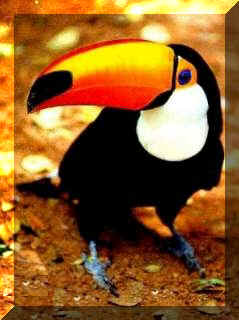
 There are about 40 different kinds of toucans. They vary in size from
about 7 inches to a little over two feet. They have short and thick
necks. Toucans are distinguished by large, colorful, yet lightweight
bills. The color of the bill may be black, blue, brown, green, red,
white, yellow or a combination of colors. The bright colors on his bill
help to attract a mate. Toucans also have a narrow, feather-like tongue.
They can be noisy birds with their calls sounding harsh and raspy. A toucan's bill is sharp and has saw-like
edges. The bill is used to squash the many kinds of fruit and berries he
eats. He may also use the saw-like edges to tear off parts of larger
fruits. Also included in their diet are small birds and lizards. Toucans
make their homes in holes in trees. They are weak fliers and usually
short-glide or hop among tree branches in the canopy layer, searching for fruits
and berries. They usually live in pairs or small
flocks. White, glossy eggs are laid once a year and when they hatch, the
new chicks have no down covering them. Toucans are found in South and Central America in the canopy layer of
the rainforest. When they sleep, they turn thier heads around and tuck
their bills under their wings and tail. The toucan is very important to
the rainforest because they help to disperse seeds from the fruits and
berries they eat.
There are about 40 different kinds of toucans. They vary in size from
about 7 inches to a little over two feet. They have short and thick
necks. Toucans are distinguished by large, colorful, yet lightweight
bills. The color of the bill may be black, blue, brown, green, red,
white, yellow or a combination of colors. The bright colors on his bill
help to attract a mate. Toucans also have a narrow, feather-like tongue.
They can be noisy birds with their calls sounding harsh and raspy. A toucan's bill is sharp and has saw-like
edges. The bill is used to squash the many kinds of fruit and berries he
eats. He may also use the saw-like edges to tear off parts of larger
fruits. Also included in their diet are small birds and lizards. Toucans
make their homes in holes in trees. They are weak fliers and usually
short-glide or hop among tree branches in the canopy layer, searching for fruits
and berries. They usually live in pairs or small
flocks. White, glossy eggs are laid once a year and when they hatch, the
new chicks have no down covering them. Toucans are found in South and Central America in the canopy layer of
the rainforest. When they sleep, they turn thier heads around and tuck
their bills under their wings and tail. The toucan is very important to
the rainforest because they help to disperse seeds from the fruits and
berries they eat.
Macaw
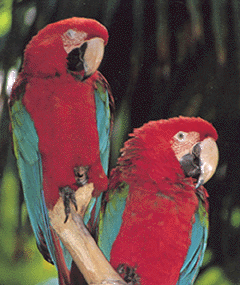 Macaws are the largest of all parrots. There are 16 different species
of macaws and they range in size from a little over three feet to one
foot. They have beautiful, graceful, tails that are as long or longer
than their bodies. They also have long, pointed wings that enable them
to fly swiftly. Macaws have sharp, hooked bills which are perfect for eating nuts,
fruits, and seeds. The beak is strong and is used to break open nut
pods. Their feet have a very strong grip which allow them to grasp
easily. Two of their toes point forward and two point backward. They can
use their foot to grasp food and bring it to their mouth. Macaws are very social and intelligent
animals. They can be found in Central and South America in the canopy
and emergent layers of the rainforest. They like to nest in holes in
trees. Macaws are on the endangered species list because their numbers
are declining due to rainforest destruction and people capturing them
for pets.
Macaws are the largest of all parrots. There are 16 different species
of macaws and they range in size from a little over three feet to one
foot. They have beautiful, graceful, tails that are as long or longer
than their bodies. They also have long, pointed wings that enable them
to fly swiftly. Macaws have sharp, hooked bills which are perfect for eating nuts,
fruits, and seeds. The beak is strong and is used to break open nut
pods. Their feet have a very strong grip which allow them to grasp
easily. Two of their toes point forward and two point backward. They can
use their foot to grasp food and bring it to their mouth. Macaws are very social and intelligent
animals. They can be found in Central and South America in the canopy
and emergent layers of the rainforest. They like to nest in holes in
trees. Macaws are on the endangered species list because their numbers
are declining due to rainforest destruction and people capturing them
for pets.
Antbird

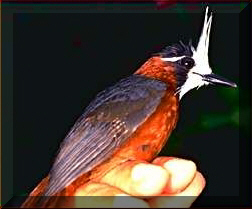 Many different kinds of antbirds exist. They are usually dull-colored birds that
feed on insects such as ants and termites. The most famous antbirds are those that are associated
with army ants. When the ants set out on a "raid", the birds follow
them as they move. The birds stay near the front lines of the advancing ant
army, and capture insects, spiders, scorpions, etc. that are trying to escape
from the ants. Antbirds don¡¦t usually eat the army ants themselves, but they
do seize and steal animals already caught by the ants, in addition to those
trying to escape or outrun them. Antbirds also sometimes move through the forest in a large mixed-species flock
that may contain as many as ten different species of antbirds and many other
kinds of forest birds (e.g. tanagers, antshrikes, and antwrens) in a kind of
cooperative hunting party. These large groups of birds flying through the forest
at several different levels like a "bird wave" scare up many different
insects. Antbirds are a specialized species, and are one of the
first to disappear when the forest is damaged or disturbed.
Many different kinds of antbirds exist. They are usually dull-colored birds that
feed on insects such as ants and termites. The most famous antbirds are those that are associated
with army ants. When the ants set out on a "raid", the birds follow
them as they move. The birds stay near the front lines of the advancing ant
army, and capture insects, spiders, scorpions, etc. that are trying to escape
from the ants. Antbirds don¡¦t usually eat the army ants themselves, but they
do seize and steal animals already caught by the ants, in addition to those
trying to escape or outrun them. Antbirds also sometimes move through the forest in a large mixed-species flock
that may contain as many as ten different species of antbirds and many other
kinds of forest birds (e.g. tanagers, antshrikes, and antwrens) in a kind of
cooperative hunting party. These large groups of birds flying through the forest
at several different levels like a "bird wave" scare up many different
insects. Antbirds are a specialized species, and are one of the
first to disappear when the forest is damaged or disturbed.
Harpy Eagle
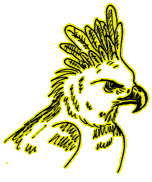
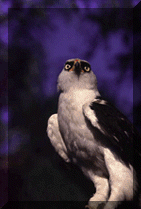 The largest and most ferocious of the world's eagles, the Harpy is a bird that
is rare and infrequently seen. It is the top predator in the jungle canopy, and hunts
by day. It is a heavy bird in flight, with a powerful bill and talons. Its wings
are rounded, strong and relatively short, and its tail is long: a body shape
that makes it agile and highly maneuverable in flight, and enables it to chase
monkeys through the canopy branches at high speeds. Its mottled gray plumage
provides good camouflage. Hunting mainly in the canopy, it can swoop down through
the tree crowns and with outstretched giant talons capture fleeing monkeys, or
snatch sleeping sloths. Harpy eagles nest in the tallest emergent trees, often silk cotton trees; the
nest is a large platform of twigs that is used from year to year. Normally, two
eggs are laid, but only one chick is successfully reared to adulthood, in about
6 months. One pair of harpy eagles that were carefully studied by
scientists was found to prey mainly on two animals: sloths and capuchin monkeys.
Other animals caught and eaten included opossums, agouti, small deer, tree
porcupines, kinkajous, howler monkeys, snakes, ant-eaters like the tamandua, and
large parrots.
The largest and most ferocious of the world's eagles, the Harpy is a bird that
is rare and infrequently seen. It is the top predator in the jungle canopy, and hunts
by day. It is a heavy bird in flight, with a powerful bill and talons. Its wings
are rounded, strong and relatively short, and its tail is long: a body shape
that makes it agile and highly maneuverable in flight, and enables it to chase
monkeys through the canopy branches at high speeds. Its mottled gray plumage
provides good camouflage. Hunting mainly in the canopy, it can swoop down through
the tree crowns and with outstretched giant talons capture fleeing monkeys, or
snatch sleeping sloths. Harpy eagles nest in the tallest emergent trees, often silk cotton trees; the
nest is a large platform of twigs that is used from year to year. Normally, two
eggs are laid, but only one chick is successfully reared to adulthood, in about
6 months. One pair of harpy eagles that were carefully studied by
scientists was found to prey mainly on two animals: sloths and capuchin monkeys.
Other animals caught and eaten included opossums, agouti, small deer, tree
porcupines, kinkajous, howler monkeys, snakes, ant-eaters like the tamandua, and
large parrots.
Piranha
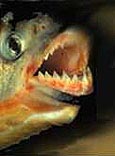
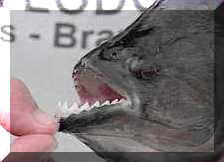 The piranha is a small, predatory fish (very abundant throughout the Amazon basin) that is activated into
a feeding frenzy by the smell of blood. Their teeth are so sharp that
they can strip a 100 pound animal to the bone in a minute.
Under normal conditions, piranha pose little threat to humans, much preferring a diet
of fish. However, when water levels drop and their normal food supply is
diminished, piranha will attack ¡§other¡¨ sources of protein. Indigenous people in some regions along the Brazilian
Amazon catch some fish by using a toxin found in a local plant to temporarily
paralyze the fish. This same toxin is used to control the piranha population
when it gets high enough to deplete other fish species.
The piranha is a small, predatory fish (very abundant throughout the Amazon basin) that is activated into
a feeding frenzy by the smell of blood. Their teeth are so sharp that
they can strip a 100 pound animal to the bone in a minute.
Under normal conditions, piranha pose little threat to humans, much preferring a diet
of fish. However, when water levels drop and their normal food supply is
diminished, piranha will attack ¡§other¡¨ sources of protein. Indigenous people in some regions along the Brazilian
Amazon catch some fish by using a toxin found in a local plant to temporarily
paralyze the fish. This same toxin is used to control the piranha population
when it gets high enough to deplete other fish species.
Electric Eels
 Large electric eels live in tropical rivers. Their bodies can
generate enough electricity to knock a person senseless and, in some
cases, can cause drowning. "Shocking" ... but true.
Large electric eels live in tropical rivers. Their bodies can
generate enough electricity to knock a person senseless and, in some
cases, can cause drowning. "Shocking" ... but true.